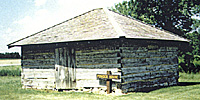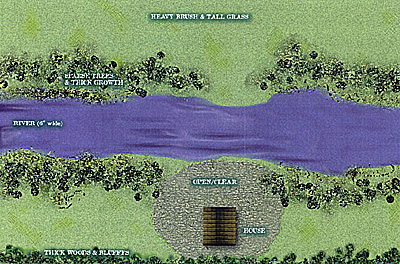When word of the Sioux Uprising reached Ft.
Ridgely, the garrison had seventy-six men and two
officers. Most of the men were in Company B, 5th
MN. Captain Marsh, a veteran of Civil War
service, had never fought Indians, and a majority
of his men had yet to see combat. Fugitives from
all over the countryside came streaming into the
fort, talking about the Indians, and "raising hell
at the Lower Agency."
Troop Types
Marsh decided to go down to the
agency and see for himself just what he could do.
Marsh took with him 46 men of Company C and
interpreter Peter Quinn. He left the fort with 29
men under a green, 19 year-old Lieutenant. The
soldiers met a lot of panic-stricken settlers along
the way, who warned Marsh and his men about the
Indians, and that he had not taken enough men.
They told him not to go down beyond Redwood
Ferry. Confident of his mens ability to put down
some rowdy Indians, Marsh did not listen.
A mile from the Ferry, Marsh's
men had to get out of the wagons they rode in
and began walking. In a single file line, they
marched through the thick brush along the river.
Around noon the soldiers approached the grassy
landing at the ferry. Hazel and willow brush
grew thick all along the banks of the river.
A few trees bowed over the lazy
stream and meadow larks piped playfully on the
bluffs above. The ferry house was quiet. The boat
rode tethered to the shore.
From across the river came a voice
beckoning Marsh to cross over with his men. The
man calling was White Dog, a "cut-hair" who
had been hired to teach the Sioux how to farm.
He called for Marsh to come over and have a
council. (Later, at WhiteDog's trial, he would
claim that he did in fact warn Marsh not to come
over and that there was an ambush.)
Nearly surrounded Marsh led his
men down the only route of escape. He took to the
heavy brush that ran along the river for about two
miles. Once clear of the brush he figured on
turning to the open prairie where he could match
the Indians on open ground. When the men got to
the end of the brush, they saw more Indians
blocking the way back to the fort. The only way to
go now was across the river.
As he led his men swimming across
the river, Marsh drowned. Sgt. John Bishop then
took command, and under cover of dark, got the
fifteen survivors back to the fort and relative
safety. Eight more men came in later that night. It
was a miracle that any man made it back at all.
Only one Sioux had been killed. The fight at the
ferry had given the Indians confidehce. Now they
knew that they could "kill the white men like sheep."
Marsh has two squads of 10 regular men armed with rifles. You can use all 46 if you'd like. Marsh and Quinn are mounted and are also 'regular.' The Sioux get 3 groups of regular musket/bow
armed men. Again, feel free to give them as many as you want (but be sure that they out number the Army). All troops on both sides fire as 'green.' Be sure to use the ambush rules from the BAB rules as well.
The table is 6'x4' but it can be played on a 4x4' table instead. The river should run down just one side of the middle of the table, long ways. At the time of the fight the river was about 20 yards wide. There should be thick brush and trees along both sides of the river and scattered around the rest of the table but for a clearing around the house and ferry crossing. The river can be about six inches wide from top to bottom shores (wide enough that you need a boat to cross but may still shoot over it.)
The ferry house should be centered but on the edge of the wide side of the table and
should hold at least ome group of figures. Behind the house the bluffs rise about 40 feet and are very steep. Consider this impassable. The Indians may deploy anywhere on the table within the guidelines set in the rules for ambushes. Although you can use the "White-Dog ruse" it probably won't work. Though it is fun to put him across the river "waving". Marsh and his men enter per the map.
The Indians win by killing all of the Soldiers. The Army win by surviving. Finally,
the Soldiers must go to the clearing before they can leave.
 THE ONLY ORIGINAL STRUCTURE, A MAGAZINE, AT THE ONE-TIME SITE OF FORT
RIDGLEY. IT WAS USED AS A BLOCKHOUSE DURING A BATTLE. : PHOTO BY CHARLIE JOHNSON BENNETT
THE ONLY ORIGINAL STRUCTURE, A MAGAZINE, AT THE ONE-TIME SITE OF FORT
RIDGLEY. IT WAS USED AS A BLOCKHOUSE DURING A BATTLE. : PHOTO BY CHARLIE JOHNSON BENNETT
TYPE MORALE FIRE
Sioux Green/Regular
Green/Regular CIVILIANS Green
Green
VOLUNTEERS
Green/Regular Green/Regular
ARMY Regular/Elite
Regular  MONUMENT AT THE SITE OF FORT RIDGLEY, MN : PHOTO BY CHARLIE JOHNSON-BENNETT
As Marsh talked over the situation with Quinn, a restless shot rang out and then a
full volley ripped from hidden Indians. Quinn was
hit and Marsh's Mule went down. Twelve other
men were hit in the first volley. Marsh rallied his
men and gave fire to some of the Indians who had
taken the ferry house. The soldiers were hit from
three sides.
MONUMENT AT THE SITE OF FORT RIDGLEY, MN : PHOTO BY CHARLIE JOHNSON-BENNETT
As Marsh talked over the situation with Quinn, a restless shot rang out and then a
full volley ripped from hidden Indians. Quinn was
hit and Marsh's Mule went down. Twelve other
men were hit in the first volley. Marsh rallied his
men and gave fire to some of the Indians who had
taken the ferry house. The soldiers were hit from
three sides.
The Game

BIBLIOGRAPHY
THE Sioux UPRISING OF 1862, BY CARLEY, KENNETH. ST. PAUL: MINNESOTA HISTORICAL SOCIETY, 1976.
THE CIVIL WAR IN THE WEST, BY JOSEPHY, ALVIN M. JR. NEW YORK: VINTAGE BOOKS, 1991.
THE GREAT SIOUX UPRISING, BY OEHLER, C.M. NEW YORK: OXFORD UNIVERSITY PRESS, 1997.
OVER THE EARTH I COME, BY SCHULTZ, DUANE. NEW YORK: ST MARTINS PRESS, 1992.
FRONTIERSMEN IN BLUE, BY UTLEY, ROBERT M., LINCOLN: UNIVERSITY OF NEBRASKA PRESS, 1981.
Dogs in the Hot Moon Introduction
Dogs in the Hot Moon Background
Back to The Zouave Number 49 Table of Contents
Back to The Zouave List of Issues
Back to Master Magazine List
© Copyright 1999 The American Civil War Society
This article appears in MagWeb (Magazine Web) on the Internet World Wide Web.
Other military history articles and gaming articles are available at http://www.magweb.com